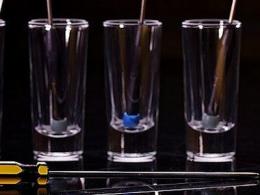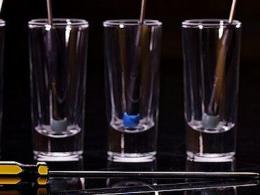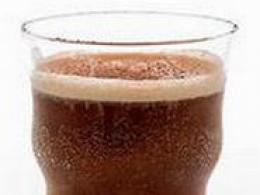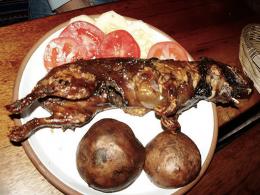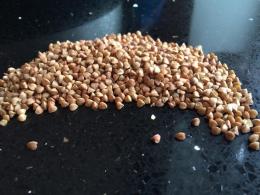Jägermeister what herbs. Classic serve
Initially, this liquor was created as a drug to improve digestion. Assessing the taste of the drink, the "patients" began to use it just for fun. But due to the high strength and specific composition, a special approach is required here. I will tell you how to drink Jägermeister in different ways. We will consider the nuances of serving, snacks and the most successful cocktail recipes.
Jägermeister(from the German "Jägermeister" - senior huntsman) is a popular German liquor with a strength of 35 degrees, produced by maceration (infusion) of herbs, followed by aging of the finished drink in oak barrels. Produced since 1935 by Mast-Jägermeister AG in Wolfenbüttel (Lower Saxony).
Since 1970 Jägermeister has been actively exported to more than twenty countries. Initially, the drink was popularized by heavy rock bands, among them was even the legendary Metallica. A significant role in the conquest of the world market by the liquor was played by advertising in Formula 1 and DTM races. For some time, the inscription "Jägermeister" even showed off on Porsche 956 sports cars.

Jägermeister composition and production
The exact recipe is kept secret. It is only known that the composition includes 56 ingredients, including alcohol, water, caramel, sugar, ginger, cinnamon, spicy cloves, coriander, saffron, etc.
There is an opinion that the liquor contains deer blood, but the manufacturer denies this. The legend appeared after the group Inkubus Sukkubus called Jägermeister “the sweetest blood from deer antlers” in one of the songs, and fans literally took the metaphor of the musicians.
After harvesting, the herbs are dried, ground and mixed in certain proportions. Next, the mixture is poured with alcohol, insisted and distilled several times. The resulting liquor is aged for a year in oak barrels. Next, the drink is filtered, sugar and caramel are added, then insisted for another six months. At the final stage, Jägermeister is poured into special dark glass bottles that protect the drink from the negative effects of sunlight.
Methods to drink Jägermeister
1. Ice shot (classic). Suitable for those who want to drink pure Jägermeister. First, the bottle is cooled for several hours at a temperature of -18 ° C, then the liquor is poured into vodka glasses (called “shots” in the West), which are also cooled beforehand. The glass is drunk in one sip (in one gulp).
 ice shots
ice shots Cold Jägermeister becomes viscous and sweetish in taste. Alcohol is not felt, only the aroma of herbs. The drink is ideal for an aperitif (alcohol served before the main meal).
2. Warm Jägermeister. Drink at room temperature. The taste is a bit bitter, but the aroma of herbs is revealed better than when chilled. Only 20-40 ml of liquor increase appetite and cheer up.
Most often, this method is practiced for therapeutic or prophylactic purposes, for example, Jägermeister is good for colds. The healing properties of "Huntsman" are similar to the Riga Balsam, even in the history of these two liqueurs there is much in common.
Warning! Do not forget that Jägermeister is a fairly strong alcoholic drink with numerous herbs in its composition. For one evening it is desirable to use no more than 300 ml. Otherwise, severe intoxication or problems with the digestive system (due to extracts of medicinal herbs) may occur. I also categorically do not recommend mixing Jägermeister with beer, since the effect of this combination is unpredictable.
 Orange sprinkled with cinnamon - a trendy appetizer under the "Huntsman"
Orange sprinkled with cinnamon - a trendy appetizer under the "Huntsman" A few words about the snack. There are no generally accepted rules here, you can drink Jägermeister with the dishes you are used to. For example, the Germans eat their favorite liquor with fried sausages, the Americans eat a slice of orange and cinnamon, while in Russia lemon and salt are often practiced (vodka culture affects).
3. As part of cocktails. This method will appeal to those who like to dilute spirits. You can mix Jägermeister with orange or lemon juice, mineral water and even sprite (the optimal proportion is one to one), but it is much more interesting to make cocktails with Jägermeister, the best recipes are presented below.
1. "Black Blood".
Ingredients:
- Blue Curacao liqueur - 50 ml;
- Jägermeister - 20 ml;
- sprite - 25 ml.
Preparation: Mix all ingredients in a shaker with ice and strain into a martini glass.
2. "Cucumber".
Ingredients:
- sprite - 150 ml;
- Jägermeister - 50 ml;
- cucumbers - 150 grams.
Preparation: cut the cucumber into small strips, put in a glass with ice. Add liqueur and soda, mix with a spoon.
3. "Egermonster".
Ingredients:
- pomegranate syrup - 30 ml;
- Jägermeister - 30 ml;
- orange juice - 150 ml.
Preparation: Pour all the ingredients into a glass for serving and mix until smooth.
One of the biggest mysteries that balm and liqueur aficionados around the world are eager to discover is the composition of Jägermeister, a popular German bitter. It has been produced for more than 80 years, and during all this time the details of preparation have been a family secret of the owners of the Mast-Jägermeister company. The whole history of its creation is shrouded in legends, which has fueled interest in this balm for decades.
Let's try to separate the wheat from the chaff and find out what is known about this exquisite drink.
The history of the Jägermeister
The history of the drink begins in 1878, when Wilhelm Mast's factory was opened in Lower Saxony. She specialized in the production of vinegar for the mining industry, but the owner did not forget about his hobby, releasing a small amount of fine wines.

The business slowly but surely developed, years passed, the son of the owner Kurt joined him. The guy was an avid hunter and dreamed of creating a drink that warms and improves digestion. For this, he became interested in herbs and demonstrated amazing ability to create original mixes.
Historical sources speak of the appearance of a unique alcohol recipe in 1934. A year later, the finished product entered the market and quickly gained popularity among German hunters. They appreciated its balanced strength, original taste and unique ability to protect against colds. Contributed to the promotion of bitters and an unusual label. According to legend, Count Hubert Palatine met an unusual deer while hunting, which became an amazing sign for him. This event was captured on the label.
Jägermeister - all about the legendary German drink
Jägermeister's strength is 35 degrees, which allows it to be classified as strong liquor. The variety of herbs remains a secret, the manufacturer only discloses information about the presence of 56 natural ingredients in the bitter.
It is well known that Mast-Jägermeister is the largest consumer of saffron. What other types of herbs form an unforgettable taste? Here is a real herbarium of blueberries, juniper, cloves, licorice, rhubarb, poppy, valerian and ginseng. People with a delicate sense of smell found Indian sandalwood, gentian, wormwood and anise in the composition. The taste is not interrupted even by degrees, and the herbs make it unforgettable.

There is little information about the manufacturing technology, the traditions of which have been carefully maintained for decades. All components are crushed, filled with alcohol and the maceration process begins, which lasts for several weeks. After filtration, the mixture is transferred to barrels, the number of which is 445 from year to year, and infused for more than six months, after which it is supplemented with honey and caramel. It turns out a drink with a deep dark color and a rich herbal aroma. It is used as an aperitif or digestif, to stimulate the appetite or, conversely, to aid digestion after a hearty dinner.
What herbs are included in the composition, how many of them and whether there is deer blood there - all these details are under the cloak of secrecy. Attempts to create a similar bitter have failed with many competitors.
Varieties of liquor
Not long ago, the company released a limited edition Spice with 25 percent alcohol and increased vanilla and cinnamon for those who are just starting to join this balm. The new taste has already found its fans.

Will it be as popular as bitter, which has become a classic in the fight against poor appetite, colds and depression? So far, this is the same secret as the composition of the traditional Jägermeister.
Jägermeister is a German herbal bitter liqueur, which was originally intended to be used as a medicine to increase immunity and improve digestion. Over time, the situation has changed and now herbal liqueur pleases lovers both in its pure form and in cocktails. The drink is especially popular at ski resorts, since the natural base still has a general strengthening effect on the body, especially if you do not abuse alcohol. Let's figure it out.
Jägermeister is a popular German liqueur with a 35% alcohol content. The exact recipe is kept in the strictest confidence. There are many legends around this secret, one of which says that deer blood is added to the liquor. In fact, this is not the case, however, manufacturers are silent on this matter and are in no hurry to dispel prejudices.
The history of the creation of an alcoholic beverage begins in the 19th century. For the first time, they began to produce it at the factory of Wilhelm Mast, whose main activity was the production of vinegar. The owner's son participated in the creation of the Jägermeister recipe, he had a unique talent for mixing various herbs and creating unique tastes. includes herbs, including saffron, ginseng, poppy, juniper, licorice and others. This is only part of the recipe, as the full composition is kept in the strictest confidence.
The components are crushed, placed in a barrel and poured with diluted alcohol. prepared for a little over a year. During this time, many checks are carried out for compliance with the quality standard. The result is a bittersweet drink with a bright herbal flavor. It clearly resembles a medicinal mixture and actually promotes active digestion. In this regard, it is used as an aperitif. It is difficult to convey in words the range of taste of this liquor, but it is worth noting that there is not a single gram of chemistry in the composition, the whole taste is based solely on natural ingredients.
The signature bottle of Jägermeister is adorned with a deer head with a cross. The creators were inspired by the legend of those times, about a count-hunter who once saw a deer, between the horns of which a cross shone. After that, the count took the veil as a monk. The deer from this fairy tale became the symbol of the hunting drink Jägermeister.
Now let's move on to the question of whetherhow to drink "Jägermeister". We remind readers once again that this is an aperitif, originally created as a medicinal syrup that improves digestion. Despite this, it is often drunk after dinner. It will be useful to drink a glass of liquor before going to bed if you are haunted by the feeling of an upcoming cold.
In its pure form, the drink is best drunk chilled. In this case, his bitterness goes away. The liqueur itself takes on a viscous texture and pleases with a grassy sweetness. Before use, a bottle of liquor is sent to the freezer so that it is thoroughly cooled. The glass should also be cooled and drink the bitter immediately, without waiting for it to warm up. 
Many prefer liquor in cocktails, by the way, there are a great many of the latter. The taste of herbs gives cocktails a special charm. Here are some recipes for popular Jägermeister blends.
As for the snack, despite the decent strength of the Jägermeister, it is not required. When chilled, alcohol is practically not felt in the drink, and it is drunk with incredible ease. However, there are a number of foods that go great with bitters.
- The Germans prefer to drink their liquor with hunting sausages.
- Americans eat Jagermeister with oranges.
- In Russia, it is customary to drink liquor with lemon and salt, like tequila.
As you can see, there are a lot of preferences and therefore it is precisely to determine with what andhow to drink "Jägermeister"is simply impossible. The only rule in this matter, which should be adhered to steadily - the appetizer should be cold. Hot dishes will completely ruin the whole experience of the drink.
As mentioned above, this alcohol has shown itself well in cocktails and their diversity can only be envied. We also promised to give examples of some particularly successful mixtures containing liquor.
The classic way to use a beater is called "Ice Shot". That is, both the drink and the dishes from which it is drunk are cooled as much as possible, and a portion of alcohol is drunk in one gulp. In this case, the fortress is not felt at all, and the taste of herbs and berries is fully revealed.
Black blood
It does not require special tricks in preparation.
- Blue Curacao - 50 ml;
- Jägermeister - 20 ml;
- Sprite - 25 ml;
- Ice cubes.
Place ice in a glass and pour in the rest of the ingredients. Stir with a cocktail spoon and everything, the drink is ready to drink.
Mirage
A multi-layered cocktail that is drunk in one gulp, just like the bitter liqueur itself.
- Cointreau - 15 ml;
- Baileys - 15 ml;
- Mint liqueur - 15 ml;
- Jägermeister - 15 ml.
All liqueurs are carefully poured into the shot in layers and served to the client. It is important not to disturb the layers and mix the ingredients.
Cocktail "Kyukambe"
A mixture containing fresh cucumbers, as evidenced by its name. The drink contains a very small amount of alcohol, while it has a light refreshing taste. Used as an after-dinner digestif.
- Jägermeister - 50 ml;
- Sprite - 50 ml;
- Fresh cucumber - 150 gr;
- Ice cubes.
The cucumber is cut into thin slices and placed on the bottom of the glass. Then the glass is filled with ice and liquid components are poured. Mixing is not required.
acid alligator
This drink involves active mixing of the components in a shaker.
- Malibu liqueur - 20 ml;
- Pineapple juice - 40 ml;
- Midori liqueur - 20 ml;
- Jägermeister - 20 ml;
- Ice.
Place the ingredients in a shaker and mix. Pour into a cocktail glass and serve.
So named because of the reddish tint, reminiscent of diluted blood.
- Pomegranate syrup - 30 ml;
- Jägermeister - 30 ml;
- Orange juice - 150 ml.
The components are poured into a glass and mixed with a cocktail spoon until the color becomes uniform. It is worth noting that the taste of this low-alcohol drink has nothing to do with the name. It is perfect for people who practically do not drink alcohol. 
As you can see, there are really a lot of cocktails. Each of them has an unforgettable special taste, which is ensured by the presence of our liquor.
At the end of the discussionhow to drink "Jägermeister"I would like to remind you that despite the original taste and benefits, this alcohol contains a considerable amount of alcohol. In addition, the infusion of herbs has a medicinal effect. Therefore, in order to avoid trouble and the opposite effect, Jägermeister is not recommended to be consumed in large quantities. The recommended daily dose is 300 ml. It is also not recommended to mix liquor with sparkling alcohol, such as beer or champagne, as this can lead to unpredictable consequences.
At the moment, varieties of Jägermeister liquor are divided into 2 types: classic liqueur and Jägermeister with spices (Jägermeister Spice). Despite the long history, few people know how to drink this liquor properly.
Jägermeister in its purest form
The manufacturer's recommended way of drinking Jägermeister liquor is to use shots of ice. But in the absence of such, ordinary stacks of glass chilled with ice or from a freezer are perfect.
To begin with, a bottle of liquor is cooled for several hours in a freezer at a temperature of minus 18-20 degrees Celsius. Then it is poured into chilled vodka glasses, called shots in Europe and America. A shot of ice-cold Jägermeister is drunk as a digestif, and always in one gulp. In this case, you can fully experience the unique flavor bouquet of the drink, which, when cooled, is not distorted by alcohol.
You can also use Jägermeister at room temperature. This is usually done for medical purposes, such as for colds or to improve digestion. At the same time, the herbal component of the drink is especially clearly revealed. However, do not get carried away with treatment. Remember that 250-300 milliliters of this rather strong drink can cause severe alcohol intoxication.
Jägermeister in mixes and cocktails
If there is no desire or opportunity to drink Jagermeister in its pure form, it is allowed to use it in various mixes. So, it is often mixed in a 50/50 ratio with citrus juices, mineral water or sprite.
And finally, Jagermeister is a fairly common ingredient used when mixing dozens of conventional, exotic and even semi-marginal cocktails. Among the most common drinks containing German liquor, Mirage, Cucumber, Black Blood, Jägermonster and Alligator on acid are worth mentioning.
Suitable snacks
Speaking of snacks that are best combined with Jägermeister, it should be noted that in the historical homeland, this drink is most liked to be eaten with local fried sausages. In the United States, the liqueur is usually served with orange slices flavored with cinnamon, while in Russia salted lemon slices are preferred. But, in principle, there are no strict prescriptions in this case.
And the last thing: when raising a glass of this well-deserved liquor in a male company, do not forget to say the classic Jägermeister toast: “For the hunters!”.
Brief history of the drink
The well-known and beloved German herbal liqueur Jagermeister originated in 1934 in Lower Saxony. Its name can be translated into Russian as "senior hunter" - an allusion to the court position that once existed in numerous German states.
Jägermeister is by nature much closer to tinctures than to liqueurs. Jägermeister's fortress is 35 degrees. It contains 56 different ingredients, including: water, alcohol, sugar, caramel, anise, ginger, licorice, coriander, cloves, cinnamon, saffron, orange peel and many others. It is not surprising that such an intricate drink requires a special approach.
Of all the German bitters, it was the Jagermeister liqueur that managed to become a symbol of Germany, displacing the world-famous beer from the pedestal. More than fifty components, a strictly classified recipe, an unusual advertising campaign that linked the drink in the minds of the masses with the music of rebel rockers - all this made the frankly brutal and bitter drink popular all over the world. The Americans, to soften the taste of German herbal liquor, came up with an automatic machine that cools the drink to sub-zero temperatures. And in Europe, cocktails are prepared from Jägermeister, sometimes simply stunning in their effect.
Composition and preparation technology
The German Jägermeister liqueur is made up of alcohol, sugar and 56 different herbs, roots, fruits and spices. Manufacturers strictly keep the secret of the full recipe of their offspring, but some of the ingredients are still open to the public. So:
- alcohol;
- water;
- sugar;
- caramel;
- peels of bitter oranges;
- cardamom;
- anise;
- cinnamon;
- ginger.
This composition is reliable and is not hidden. Idle tasters and connoisseurs recognized additional ingredients in the complex taste of the drink:
- liquorice;
- blueberry;
- saffron;
- rhubarb;
- juniper;
- ginseng.
The reliability of the second list is doubtful, it is based on rumors and conjectures. The remaining 44 components are a secret with seven seals.

No one makes secrets from the cooking technology.
1. A set of herbs and roots is infused in an alcohol solution for 6 months.
2. The tincture is filtered and again left for six months to “ripen”.
3. Thorough filtration again.
4. Sugar, caramel, alcohol and water are added to the finished infusion (or balm) to get the desired strength.
5. Ready liquor is bottled.
The process of maceration (infusion) takes place exclusively in oak barrels, and the bottles into which the liquor is poured are necessarily made of dark green glass. Fortress Jägermeister not less than 35 degrees. Despite the presence of sugar and caramel, the calorie content of the drink is low, which attracts ladies who watch their figure.
How to drink and what to mix with
The classic way to drink the famous herbal liqueur is in its pure form from tiny glasses for one sip. The correct Jägermeister should be very cold (the bottle is kept in the freezer for at least 4 hours before serving). Only in this case, its natural bitterness is dulled, and the taste is revealed most fully.
Jägermeister-based cocktails are distinguished by their unusual taste and freshness. The most sophisticated of them are recognized:
- Berry night - herbal liqueur (30 ml), raspberry liqueur (20 ml), lime juice (20 ml), fresh raspberries (4-5 berries), ice cubes, carbonated lemonade, mint leaf (garnish);
- Egerita - Jägermeister (20 ml), orange liqueur (20 ml), lime juice (20 ml), tequila (40 ml), crushed ice;
- Jaeger ginger - liquor (40 ml), lime (quarter), fresh cucumber (2 thin slices), ginger beer (300 ml);
- Twilight - chocolate liqueur (15 ml) and Jägermeister (30 ml);
- Black blood - Blue curacao (50 ml), herbal liqueur (20 ml), sprite (25 ml), ice;
- Mirage - Cointreau, Baileys, mint liqueurs - in equal parts (15 ml each), Jägermeister (10 ml).
The popular blend of herbal bitters with beer is not a drink for beginners. Similar delights are served in the bars of northern Europe, especially in demand in Finland. The effect is lethal.
When the question arises: “What to eat with a liqueur of 56 herbs?” There is only one answer - a slice of orange sprinkled with cinnamon. This is an alcoholic classic. As for cocktails, no additional appetizer is usually required. Interestingly, pure Jägermeister is drunk at the end of a meal, but liquor-based mixtures are excellent aperitifs that increase appetite.
Cook at home
It is almost impossible to make an exact copy of Jägermeister liquor at home, the full composition is classified, and the technology is painfully complicated. But some semblance of a drink can be created with your own hands.
Ingredients needed to create a special herbal and spicy bouquet:
- oak bark - 1 pinch;
- a bag of anise - 6 grams;
- a bag of star anise;
- cinnamon, rosemary, cumin - one pinch each;
- cloves - 1 bud;
- black pepper - 3 peas;
- coriander, thyme - a pinch;
- three slices of lemon;
- dried raspberries - a tablespoon;
- dried blueberries - a tablespoon;
- vodka - 750 ml;
- granulated sugar - 125 grams;
- water - 125 grams.
The cooking process is not difficult.
1. Put all dry ingredients in a liter jar, pour vodka and close tightly.
2. Infuse for two weeks in a dark place, vigorously shaking the jar daily.
3. Prepare syrup - mix sugar with water and heat, stirring, until the sugar is completely dissolved.
4. Pass the finished tincture through a gauze filter, add chilled syrup and mix thoroughly.
5. Pour the finished liquor into a dark glass bottle, cork tightly and place in the freezer of the refrigerator.
Liquor can be stored in the freezer for up to six months.
From St. Hubert to Nazi Goering - the history of liquor

Jagermeister is the head huntsman (sometimes they translate "old", which is wrong). The drink was offered to the public by an old and respected company, which was established at the end of the 19th century as a manufacturer of vinegar. The vinegar story ended quickly when the owner of the production, Wilhelm Mast, realized that alcohol would bring much more income to the company.
Herbal liquor called Jägermeister was invented by the son of the founder of the company, Kurt Mast. An avid hunter and nature lover, he studied old recipes, collected information about ancient balms and healing tinctures. The search for the optimal composition took a decade, and the search for the optimal bottle shape took almost five years.
In 1935, the Jägermeister went on sale. The drink was positioned as a warming liquor for hunters. The packaging corresponded to the content: the bottle was flat (fitted comfortably in a breast pocket) and it was difficult to break it.
A year earlier, "Nazi No. 2" Hermann Goering proclaimed himself "the chief hunter of the Third Reich." Liqueur even began to be called "Goering's schnapps."
To draw more attention to the new product, Mast placed on the label an image of a deer with a cross between its horns. This symbol was well known in Germany. It is associated with a touching story that happened to one of the Frankish nobles - Hubert of Liege. The brave knight loved deer hunting more than anything in the world. He killed dozens of unfortunate animals, not for the sake of food, but solely out of sporting interest. One day, a beautiful deer with branched horns came out of the forest, right under the arrow of a nobleman. A Christian cross shone between the horns ... Hubert regarded this as a sign from above and left the light, went to the monastery. Later, Hubert became a bishop, did a lot for the church, and after his death was canonized.
History has a very conditional relationship to herbal liquor, however, it is Saint Hubert who is considered the patron saint of hunting and the hunters themselves.
Jägermeister herbal liquor gained international fame in the mid-70s of the last century. Manufacturers of a strong male drink began to sponsor world tours of rock musicians and Formula 1 races. It did not work out with sports - alcohol did not go well with a healthy lifestyle. But a bottle with a deer on the label in the hands of hairy guys in leather pants looked very logical.
Today Jägermeister occupies an honorable position in the top ten most popular alcoholic beverages in the world. It is exported to 80 countries of the world, and the liquor itself has been one of the most recognizable symbols of Germany for more than 30 years.



